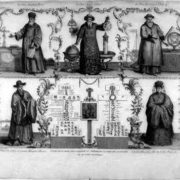The September 22 agreement between China and the Vatican is a decisive event, of which it is difficult to exaggerate the importance and whose scope will be clear perhaps only in many years. This could give some hope also about the ongoing controversy between U.S. and China which looms larger than a simple trade tussle. It may prove that China is willing to compromise if it fully realizes what is at stake.
With the Vatican, it is indeed the first time in its millennial history that a Chinese government in full power accepted a limitation of its internal powers. That is, China accepted what is in fact a division of civil and religious powers. This division is part of Western history and is a basic element of modernity. It is the difficult and painful conquest of the battle of about a thousand years ago between the emperor of the sacred Roman empire and the Pope, and it is the struggle of investiture over who had the ultimate power to name the bishops.
China has accepted this modern and Western principle, thus marking an important dogmatic step toward modernity.
This was in fact possible because the Chinese state had already been transformed with the communist and Marxist revolution. But to understand the change we need to take a step back.
The demise of
The Chinese state was founded by combining political and “spiritual” powers. The emperor is called tian zi, son of heaven, at least from the first millennium BC during the Zhou dynasty, which dominated the plain of the Yellow River in what could be called the “Ur-China.” Heaven then was clearly an almost humanized deity. In the following millennia, the divine value of heaven changed, but the “son of heaven”, in addition to governing, continued to preside at civil/religious ceremonies and punctuate the administration of the state according to seasonal rhythms – that is, of those of heaven. For example, death sentences were performed in the fall and amnesties in the spring.
This religious value is much less metaphysical than the Western one and much more ideological. The ceremonialism of the state asked the Chinese people to identify themselves ideologically with the thought of state. Thus, all religions had freedom as long as they did not limit imperial power but were absorbed in the great imperial power. The nomination of the bishops could not for this reason be minimally divided or shared with an external power physically (because he is in Rome, like the Pope) and ideologically (as with the Pope).
This is all the more true when one sees the experience of the German Jesuit von Schall in the 17th century. He was one of the most powerful men of the empire and called “uncle” by the emperor. At his funeral, the emperor tore his clothes and was first in the procession. Von Schall was for a time a kind of Richelieu of the empire. Yet despite all this power, he not only failed to convert the emperor, who remained skeptical about many aspects of the political impact of Catholic doctrine, but could not even get a bishop appointed in Beijing or the papal legacy acknowledged!
The monolithic nature of political power was in fact broken in principle by the adoption of materialist Marxist ideology, which expressly excluded the religious sphere from the absolute power of Chairman Mao Zedong.
Actually, during the period of Mao’s power and particularly during the Cultural Revolution, Mao was treated as a demigod, as more than the previous Chinese emperors. Every religion had to be suppressed because it hindered the semi-divine worship of Mao. But this was not framed in a state ideology like during imperial times.
So, during the Deng period, the position of the party leader ceased to be deified and religions received greater freedom of action, but the prohibition of a true and transparent role of the Pope in the choice of bishops remained, because this role was considered “interference in Chinese internal business”. That is, given that the bishops were Chinese and had at least a social – and therefore political and ideological – role in the Chinese state, and the Pope was out of the state, the Pope could not play any role in the choice of bishops.
The Falun Gong crisis in 1999 showed, however, that the Chinese, like everyone, could not do without religion. On the other hand, the communist state, therefore a materialist state, could not provide a “state religion” or it would run into the problems already experienced with Mao. The state had to try to “contract” faith to “reliable” religions.
From the beginning of the 2000s, the problem became a question of whether Catholicism and its leaders in Rome were reliable and whether relations with them maintained that they were outside China and had a very different role.
A Confidence Deal
The agreement was concluded on the basis of the Beijing government’s confidence in the Holy See. This trust cannot be only toward this Pope, but must be toward the institution. The Chinese do not trust a momentary event, a person who is there today and tomorrow is not. In these 20 years, trust has been built with three Popes: Wojtyla, Ratzinger, and Bergoglio; and therefore China trusts that this relationship will also be maintained by their successors on the same basis. There is nothing changed today compared to 20 years ago, when the reports were viewed positively in the international context.
However, the international situation has changed with the current tension between China and the United States. The US and other countries fear that a normalization of relations with the Vatican is a blessing of the Holy See to China. Even without being a blessing to China, such relations introduce an element of prudence in the whole international context that seems to slip almost absently toward a new cold war. Part of this vision is also the interpretation of the recent measures on religion as a campaign against religion in China.
There is no campaign as such against Catholics or Protestants in China. It is important to understand what is actually happening in China, with the good and bad. In 1999, for instance, from July to September there was a campaign against the Falun Gong and within about two months the Falun Gong disappeared from China. We are speaking of a force of over 100 million followers, embedded in the army, the police, and deep in the party. Yet in two months, they were erased. That was a campaign.
If the party wanted to go against Christians (who are not so strong in the party, army, or police), they would have disappeared or gone underground. Then it is not a campaign. What is happening actually is an application of the new regulations about registration of priests and churches. In theory, this is not wrong. In Italy, for instance, for reasons of public security, churches and priests, be they Catholic, Protestant, or Muslim, have to be registered with the relevant authorities. This regulation in China is unprecedented. The Chinese are used to sweeping campaigns, but not to this selective and flexible application of laws and regulations.
Moreover, in many places, officials feel safer if they are more rather than less severe. If you are too zealous, the system doesn’t blame you. Besides, some priests are afraid of the government, and do not believe it had a change of heart, so therefore they refuse to register. Some other religious groups declare themselves Christian or Catholic but are actually a mishmash of old Taoist beliefs. They are what people would call “pseudo-Christian,” like the 19th century Taiping, who revolted against the imperial power, leading to a war in which some 20% of the population of the time was killed. The government fears that some of these pseudo-Christians could lead to that kind of uprising, and many normal Chinese are against Christianity, considered almost an offense against their traditional faith. These sentiments may be right or wrong, but we have to know that they exist and we should cope with them.
Then, we can see that the situation is extremely complex. Even honest local officials have issues telling who’s who in the chaotic world of new Christianity. In all of this, it is a miracle and actually a blessing that in reports to Rome some 85%–90% of Catholic communities in China report there have been no incidents and they are very happy with how things are going. Then there is hope that things will be sorted out and the agreement will expand room for religious freedom for all in China.
Back to integration of China
From the minuscule (some very important, concrete issues), we then need to return to a broader perspective.
The Catholic Church has so far been the ideal and cultural continuity of the West, father and mother of modernity. The Church has never totally separated from its various schismatic interpretations of the Orthodox and Protestant churches in their thousand rivulets. So the meeting/understanding of China with the Church is central, and actually late, with the Chinese bet to modernize.
Somehow before meeting the Church and its tradition, China met modernity in its latest, most flamboyant version: America. But America does not come from nowhere; it comes from a very long history that has moved to the American continent. To understand America, its history, and its logic today, there is only one institution in the world – the Catholic Church, which with its 2,000 years of history represents the greatest cultural continuity of the West – equals America.
Perhaps part of the problem between China and the US – which has led to mutual irritations on trade, economics, strategy, and politics – so far is one of great cultural misunderstandings. China has assumed that America was a sort of cultural mushroom that emerged in the last 250 years. But understanding the tradition and culture of the Church, which then has a specific weight in America, as the country’s single major religion, helps to understand American dynamics.
On the other hand, the Church realizes that it must emerge from itself, from this cultural tradition. With 60% of the population and global economic growth, the world’s future is in Asia. But here the Catholics are perhaps 2% of the total population, if we exclude the South American appendix in Asia that is the Philippines. That is, if the Church is not in Asia, it becomes not a Catholic church, but a neo-Anglican or neo-Orthodox church that is so closely linked to specific cultural and political realities as to become a mere bastion of tradition and ideology. If the church wants to remain Catholic, universal, it must go to Asia.
This is what the Church is doing today, placing itself as a great mediator of political and cultural conflicts. As recently explained by Cardinal Pietro Parolin, diplomacy is “a privileged instrument for overcoming opposing political ideas, different religious conceptions, or different ideologies.” Asia is in dire need of this, with its thousands of unresolved conflicts and with the fact that in essence the Cold War is not over yet, as demonstrated, for example, by the continued existence of Communist countries (China, Vietnam, and North Korea) and the territorial division between the Koreas and between mainland China and Taiwan. The Church has already been dragged into these conflicts, in fact.
But to be truly present, the Church cannot impose itself, as in the days of colonialism, with its Latin-Greek culture, as if it were the long hand of the colonial power on duty. It must take root deeply in the various territories. Recent research on Buddhism and on Taoism is a very early beginning of this approach that actually takes place at a time of great change in Asia.
The continent we see today as unitary was actually less than a century ago essentially divided into three: there was the Indian world, the Chinese one, and the Indochinese one, a land of border and admixture. These had separate dynamics, precisely due to the difficulties of overcoming geography and the histories that had evolved separately.
Now that geography is less of an obstacle thanks to modern airplanes, roads, railways, and telecommunications, the former three Asian worlds are increasingly integrated. But there remain great differences and hatreds. What everyone has in common is the desire to be modern and developed. That is, the Chinese problem of modernity is not only of China, but of all the countries of the region. Moreover, while at the time of the Jesuit missionaries in the 16th and 17th centuries the Buddhist church was a very strong presence opposed to Catholic missionaries, today Buddhism is very much in crisis everywhere and in reality the presence of the Catholic Church could even help a return to more authentic Buddhism.
Each country then has specific problems and without being an illusion it will take centuries for the Catholic presence to consolidate, if it ever becomes consolidated. China is a sort of religious semi-desert, where traditional faiths no longer exist and those that remain are disorganized, out of control, and culturally often very weak.
India, on the other hand, is in the midst of a sort of revolution in Hinduism. The former power of the a-religious Congress party is waning and political Hinduism is sprouting with the ruling BJP. There traditional Hinduism appears to be redefined with less emphasis on castes and more on a common identity. This creates perhaps an even more precarious balance with the Muslims of India proper and those living in Pakistan, which was always considered some kind of “enemy of the heart”.
In the rest of the continent, Catholics are minorities who today are able to play a role perhaps also because they are urged and encouraged by the dynamic presence of this Pope. But often it is about closed minorities. In Japan, they are a small group that for centuries de facto has kept faith in exchange for the commitment not to spread it to others. Today a prospect of evangelization would be the breaking of the old pact and therefore the signing of a new cultural “agreement” with the emperor, the symbol of the cultural continuity of the country. A similar and perhaps worse situation is found, for example, in Thailand, where Catholics are only Thais of Chinese or Vietnamese descent who have arrived in the country already Catholic. They too cannot evangelize and the Thais are de facto forbidden from converting.
In this situation of many traps, the Church moves, trying not to fall. Compared to the other traps, the Chinese question is perhaps not the worst. In this, the Church wants to be of help. A moment of cultural, religious, and political crisis is an opportunity for the future of the Asian Church to be realized.






Nessun commento